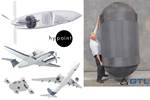GTL validates LH2 composite dewar tanks for use in aviation
Test results exceeded expectations regarding holding hard vacuum, heat load, rapid chill-down and hydrogen fraction goal, leading to flight prototype fabrication.
Share
Read Next
Gloyer-Taylor Laboratories Inc. (GTL, Tullahoma, Tenn., U.S.), an aerospace engineering R&D company, has shared in-depth results from the successful validation testing of its small, subscale composite vacuum jacketed dewar tank with liquid hydrogen (LH2).
According to GTL, test results surpassed expectations. When fully isolated, the dewar tank held hard vacuum at 2.8.e-6 torr for approximately 50 minutes with LH2, which was the company notes is >100 times better than the requirement. This enabled the GTL dewar tank to hold LH2 for more than 21 hours, at -430°F while remaining leak tight with minimal hydrogen permeation. During this test, the subscale tank experienced only 2.8 watts of heat load. Based on this, GTL expects that the flight tanks will see only 1% LH2 boiloff per day.
Results also indicated the composite tank’s ability for rapid chill-down, paving the way for aircraft to be refueled in minutes, versus waiting hours for a metal tank and transfer lines to cool. The inner composite tank went from ambient room temperature to 20 Kelvin — while holding LH2 — in less than 20 seconds and the GTL composite tubes achieved full LH2 flow in less than one second. The tests also show that no-vent fills of the composite dewar tanks are achievable, which greatly improves refueling safety.
“With these successful validation tests, we have achieved a critical milestone in aircraft decarbonization. GTL is now proceeding with the fabrication of flight prototypes of the small composite LH2 dewar tank,” says GTL President Paul Gloyer. “Our 28-inch-diameter by 53-inch-long flight-type tank weighs only 15 kilograms, including inner tank, outer vacuum shell, multilayer vacuum insulation, internal tubing and sensors, but can hold 19 kilograms of LH2.”
This gives the GTL composite dewar tank a hydrogen fraction (gravimetric index) of more than 55%, which is reported to be about 10 times better than current hydrogen tanks. When stretched to carry 50 kilograms of LH2, the hydrogen fraction increases to more than 62% with a mass of 30 kilograms, with larger versions able to achieve over 70% hydrogen fraction.
The GTL dewar tank performance exceeds the 35% hydrogen fraction goal needed for hydrogen to achieve parity with kerosene fuel (e.g., equal flight range). With GTL technology, the company contends that hydrogen-powered aircraft can exceed the performance of kerosene-fueled aircraft, while eliminating carbon emissions and reducing cost per passenger mile by more than 25%.
Related Content
-
The state of recycled carbon fiber
As the need for carbon fiber rises, can recycling fill the gap?
-
Combining multifunctional thermoplastic composites, additive manufacturing for next-gen airframe structures
The DOMMINIO project combines AFP with 3D printed gyroid cores, embedded SHM sensors and smart materials for induction-driven disassembly of parts at end of life.
-
Plant tour: Albany Engineered Composites, Rochester, N.H., U.S.
Efficient, high-quality, well-controlled composites manufacturing at volume is the mantra for this 3D weaving specialist.

















